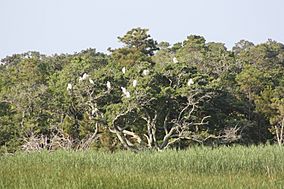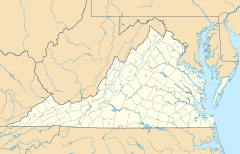False Cape Natural Area Preserve facts for kids
Quick facts for kids False Cape Natural Area Preserve |
|
|---|---|
|
IUCN Category V (Protected Landscape/Seascape)
|
|

Egrets at False Cape Natural Area Preserve
|
|
| Location | Virginia Beach, Virginia |
| Area | 3,573 acres (14.46 km2) |
| Established | 2002 |
| Governing body | Virginia Department of Conservation and Recreation |
The False Cape Natural Area Preserve is a special protected area in Virginia Beach, Virginia. It covers about 3,573 acres (1,446 square kilometers) of land. This preserve is located right next to the border with North Carolina.
Imagine a long, narrow strip of land, about 1 mile (1.6 km) wide and 6 miles (9.7 km) long. That's the preserve! It sits on a piece of land called False Cape, with the Atlantic Ocean on one side and a calm body of water called Back Bay on the other. It's one of the most untouched coastal areas in the Mid-Atlantic region.
This preserve is super important because it protects many different types of natural places. These include wet areas like wetlands and marshes, and drier areas like forests. It's home to over two dozen kinds of plants and animals that are rare in Virginia. Many of these are southern species that have reached the northernmost part of their natural home here. The preserve is also a popular stop for many birds during their long migrations in the fall and spring.
What is a Natural Area Preserve?
A Natural Area Preserve is a special place set aside to protect important plants, animals, and natural features. These areas are managed to keep them as wild and undisturbed as possible. The False Cape Natural Area Preserve was officially recognized in 2002.
Exploring the Preserve
The Virginia Department of Conservation and Recreation owns and takes care of the False Cape Natural Area Preserve. It's actually part of False Cape State Park. The preserve includes the parts of the park that have not been developed by people.
You can't drive your car directly into the preserve. The closest place to park is about 5 miles (8 km) away. From there, you can reach the preserve by hiking, boating, or by taking a special shuttle bus that runs during certain times of the year. To get to the preserve, you also need to travel through the Back Bay National Wildlife Refuge. This refuge charges a separate fee to enter.


